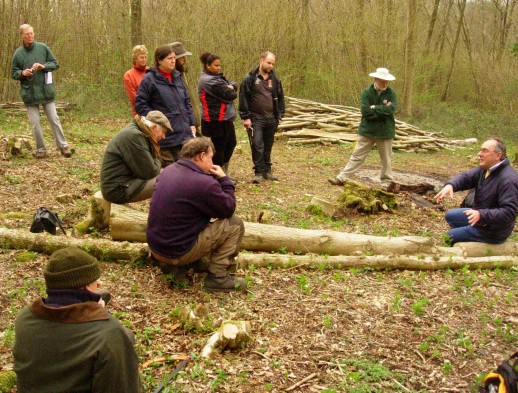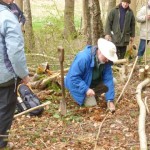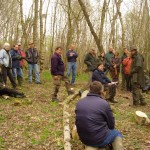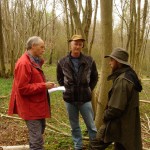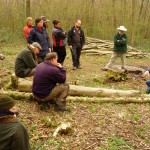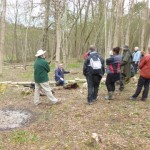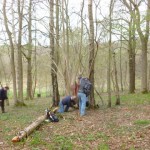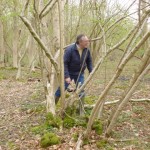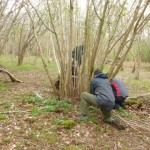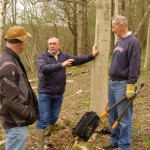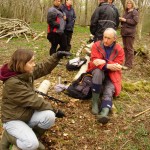Many thanks to Howard and Shirley who have sent us a nice write up and photos of their recent meeting at Clan Wood. Look out for this article and more pictures in ‘Living Woods’ magazine.
When my wife Shirley and I met Julian Evans, Alistair and Margaret Hanton in October 2011 at a Small Woods Owners Group (SWOG) meeting, we thought it would be nice a idea if we were to hold a similar event in our own Clan Wood, which forms part of Hyden Wood near Clanfield.
Alistair and Margaret are Directors of Ownwood Ltd, and their son, Angus, originally purchased all of Hyden Wood before selling some parcels of woodland to people like ourselves who wished to own their woodland.
Hyden Wood is one of a range of woodlands now in the South Downs National Park between East Meon and Clanfield, and has views towards the South Coast and the Isle of Wight.
Clan Wood slopes gently to the south and is on clay with flint over chalk. It is approximately 3.6ha (9 acres) and is made up of beech, oak, hazel, ash and some mixed broadleaves. The west side consists of a grass valley which in the past was used as a shooting ride. The remaining is Ancient Semi-natural Woodland (ASNW) coppice which we wish to restore in the coming years.
On the 14th April, eighteen people gathered at Dead Woman’s Gate in Hyden Wood for an informative day which was led by Julian Evans and Matthew Woodcock from the Forestry Commission. Julian was the Chief Research Officer for the Forestry Commission for many years and is the author of Badgers, Beeches and Blisters.
Although some of the group drove to the meeting through heavy rain when we all arrived at Dead Woman’s Gate it was dry although the sky was grey and overcast, and remained that way throughout the day.
Due to the mild winter the spring flowers were starting to show themselves although they were not as advanced as last year. The group were able to see a profusion of primroses in the valley, and bluebells in the woods although these were not quite in full flower. Sprinkled between these flowers were wood anemones’, lords and ladies, violets, common twayblade and the first of the early purple orchids.
After introducing ourselves to each other, the group walked to the valley which encloses Clan Wood on the west side.
The first topic in the programme was coppicing with standards and this was led by Julian. Those who had brought handsaws were put to work on some of the coppice stools. From these stools Julian selected hazel whips and showed the group how to cut the whip and bend it so that it can be layered to the ground.
The group were then asked to select standards they would retain, bearing in mind that the management plan aims to provide 70 to 80% exposure to light. When it was determined how few would be retained it provoked a discussion within the group; some felt that to remove this amount of timber would be excessive; but it was accepted that to achieve good quality hazel coppice this number of trees must be removed. In conclusion it was agreed that the owner must decide which and how many trees to remove as he undertakes the work, and measure that against the objectives in the management plan.
This led nicely to the second part of the morning concerning Woodland Management Plans. I gave a brief explanation of the current plan and our objectives. Our aim is to bring the first coupe back to 70% coppice with standards, but only now can we appreciate the physical requirement needed to achieve this, even with the help of contractors who undertake the chain saw work.
To date we have done the clearing, pruning and coppicing, whilst the work to thin and fell trees has been carried out by the contractor.
At this point Matthew gave an overview to the group on how to compile and apply for Management plans and grants. This included the need to apply for a Felling licence if you are going to remove more than five cubic metre of timber from site. He also emphasised that before making any application to the Forestry Commission the owner must ensure that the land is registered, without this it will be impossible to make any progress.
After lunch the meeting moved on to the types of protection available for woodlands. Within Clan wood there is an area which had been coppiced and fenced to prevent entry by deer and rabbit. It was agreed this was of a good standard, as it had also provided for the fencing material to extend approximately one foot on to the track to prevent entry at the base of the fence. The group also took the opportunity to compare this fencing with another Hyden Wood owner’s deer and rabbit fencing which had been installed within the past year. Again this fencing was considered to be of a high standard.
Tree shelters were the next means of protection to be considered. Julian gave the meeting a fascinating explanation of the origin of the plastic tree shelter and its merits in encouraging growth for small saplings.
The next aspect to consider was the control of grey squirrels. The methods shown to the group ranged from Warfarin bait through to metal traps. Julian could not emphasise enough, that if you use the latter type of trapping method, twenty four hour surveillance is essential and the dispatch of squirrels must always be handled in a humane manner.
For the final topic of the day Matthew was asked to update the group on the diseases which are causing considerable concern to woodland owners. The one with which we are all familiar is the phytophthora disease which uses rhododendron as a host and which affects nearby trees especially larch. Matthew confirmed that wherever possible this plant should be cut down and the branches and roots burnt. He also said that in recent weeks the Forestry Commission has announced the first outbreak of Asian Longhorn beetle in Kent. In addition he gave an update on the larch infection which was first seen in the South West of England and again in South Wales in 2010. Finally, in order to control the spread of disease he advocated that we adopt a clean boot policy. This consists of washing down and removing excess mud from boots and where appropriate disinfecting them when moving from one woodland to another.
At the end of the day all the members who came to the meeting said how informative they had found the programme and a vote of thanks was given to all concerned for organising the day and in particular to Julian and Matthew for giving up their Saturday and providing us with an interesting and practical day on woodland management.
Click on a picture to view at full size…
